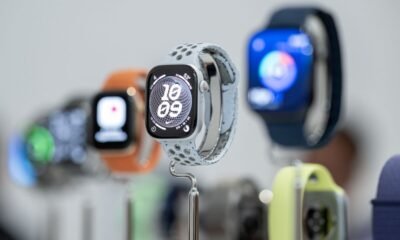Tools & Platforms
AI-Powered Wearables Transform How Consumers Interact with Everyday Technology

Tools & Platforms
Half of tech firms plotting restructures as AI hype bites • The Register
More than half of tech companies are considering a complete restructure and / or changing their operating model in response to AI, according to research from the consulting sector.
Looking at responses from consulting clients, research firm Source said that it found the changes had become a priority among the technology, media, and telecoms sector (TMT).
Using the research firm’s database and interviews with 150 clients, Source found that 60 percent of those in the tech sector expect to invest in organizational restructuring in the next 18 months.
“TMT clients remain unconfident, but advances in AI and new technologies are triggering urgent discussions about business restructuring,” the research said.
The study reveals around seven percent growth in global TMT consulting, reaching $8.25 billion. Growth last year was flat at two percent.
Tony Maroulis, principal consultant from Source Global Research, said that while the growth was not as high as in 2022, the market slowdown over the last two years has passed. “To a large extent, the crises and uncertainty faced by companies are factored into planning, and the resulting fiscal caution is gradually giving way to more ambitious investment plans,” he said.
The research showed that while 60 percent of high-tech organizations were looking to restructure, 54 percent were looking to change their target operating model, and 60 percent were considering M&As.
“Some of these changes are likely to be induced by AI (organizational restructuring, digital transformation, and operating model transformation). The M&A plan is likely to be driven by a talent shortage,” the report said.
“It is impossible to hide from the impact of AI. Few organizations – if any – do not have a roadmap for AI implementation, usually with the support of external help.”
Improving tech infrastructure is the most talked-about discussion point for telecoms clients, while media clients are explicitly focusing on using emerging technologies, the research found.
The past year has seen a shake-out at tech companies as they implement AI. For example, Salesforce has slashed 4,000 customer support roles through the application of AI agents.
“I’ve reduced it from 9,000 heads to about 5,000 because I need less heads,” CEO Marc Benioff told the media.
The company said that using Agentforce internally led to a decline in the number of support cases so that it no longer needed to actively backfill support engineer roles. “We’ve successfully redeployed hundreds of employees into other areas like professional services, sales, and customer success,” a Salesforce spokesperson said. ®
Tools & Platforms
VCs Bet on AI to Revive Slumping Consumer Tech Investments

In recent years, venture capitalists have navigated a challenging environment for consumer technology investments, marked by diminished returns and a slowdown in blockbuster exits. Funding rounds for apps, gadgets, and digital services that once captivated markets have dwindled, as economic pressures and shifting consumer behaviors favor more conservative bets. This downturn has left many investors searching for the next catalyst to reignite growth.
Yet, a cadre of forward-thinking VCs is pinning their hopes on artificial intelligence as the force that could reverse this trend. By integrating AI into everyday consumer products, they argue, startups can create novel experiences that stand out in a saturated market, potentially leading to the kind of viral adoption seen in the early days of social media.
Emerging Optimism Among Investors
This optimism is echoed in recent analyses, including a report from Business Insider, which highlights how a vocal group of VCs believes AI will transform consumer tech from its current slump. These investors point to AI’s ability to personalize user interactions, automate mundane tasks, and generate content on demand, thereby addressing the fatigue consumers feel toward repetitive apps and hardware.
For instance, AI-driven companions could evolve beyond simple chatbots into sophisticated tools that anticipate needs, such as curating personalized shopping lists or managing daily schedules with uncanny accuracy. This shift, VCs contend, moves consumer tech from passive consumption to active enhancement of daily life, potentially unlocking billions in untapped revenue.
AI’s Role in Revitalizing Sectors
Drawing from insights in a related piece by Business Insider on dating and social apps, investors are betting on AI to tackle societal issues like loneliness by fostering genuine connections through intelligent matching algorithms. Unlike traditional platforms, these AI-infused services could analyze behavioral data to suggest real-world meetups, blending digital and physical worlds in innovative ways.
Moreover, the pressure on AI to deliver economic value is immense, as noted in an Axios article emphasizing the high stakes of massive investments by companies and governments. If AI succeeds in consumer applications, it could stabilize venture capital flows, preventing a broader tech recession.
Challenges and Realistic Expectations
However, not all views are unbridled enthusiasm; some experts warn of hype cycles that could lead to disillusionment. A Business Insider analysis describes AI entering a “meh” era, where initial excitement gives way to practical evaluations, which might ultimately strengthen the technology’s foundation.
VCs like those at Menlo Ventures, as profiled in another Business Insider report, advocate for specialized AI apps that promote human connections, such as multiplayer experiences that bring people together offline. This approach contrasts with past consumer tech failures by focusing on meaningful utility rather than fleeting novelty.
Future Projections and Strategic Bets
Looking ahead, predictions from top VCs in a Business Insider forecast for AI trends suggest that 2025 could see a surge in agentic AI—systems that act autonomously on behalf of users—revitalizing sectors like e-commerce and entertainment. Investors are also eyeing regulatory changes that could ease liquidity, as discussed in a Business Insider overview of 2025 tech trends.
Ultimately, while risks remain, including potential bubbles as flagged in a Business Insider guide on spotting AI overvaluations, the consensus among insiders is that AI represents a pivotal opportunity. By solving real consumer pain points, it could not only end the slump but redefine the industry’s trajectory for years to come, provided startups execute with precision and avoid the pitfalls of overhype.
Tools & Platforms
Tranztec Intros Product to Connect Trucking Carriers’ Data, Tech

Tranztec Solutions introduced a cloud-based, artificial intelligence-driven software-as-a-service solution that makes it easier to connect trucking carriers’ data and disparate technology systems.
-

 Business2 weeks ago
Business2 weeks agoThe Guardian view on Trump and the Fed: independence is no substitute for accountability | Editorial
-
Tools & Platforms1 month ago
Building Trust in Military AI Starts with Opening the Black Box – War on the Rocks
-

 Ethics & Policy2 months ago
Ethics & Policy2 months agoSDAIA Supports Saudi Arabia’s Leadership in Shaping Global AI Ethics, Policy, and Research – وكالة الأنباء السعودية
-

 Events & Conferences4 months ago
Events & Conferences4 months agoJourney to 1000 models: Scaling Instagram’s recommendation system
-

 Jobs & Careers3 months ago
Jobs & Careers3 months agoMumbai-based Perplexity Alternative Has 60k+ Users Without Funding
-

 Podcasts & Talks2 months ago
Podcasts & Talks2 months agoHappy 4th of July! 🎆 Made with Veo 3 in Gemini
-

 Education3 months ago
Education3 months agoVEX Robotics launches AI-powered classroom robotics system
-

 Education2 months ago
Education2 months agoMacron says UK and France have duty to tackle illegal migration ‘with humanity, solidarity and firmness’ – UK politics live | Politics
-

 Podcasts & Talks2 months ago
Podcasts & Talks2 months agoOpenAI 🤝 @teamganassi
-

 Funding & Business3 months ago
Funding & Business3 months agoKayak and Expedia race to build AI travel agents that turn social posts into itineraries

















